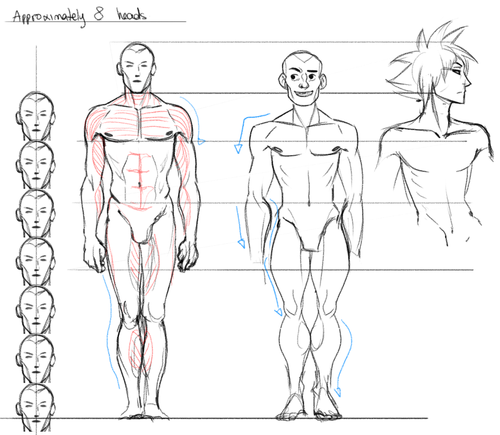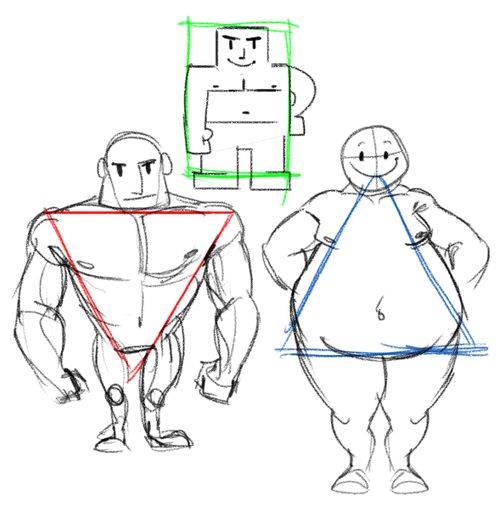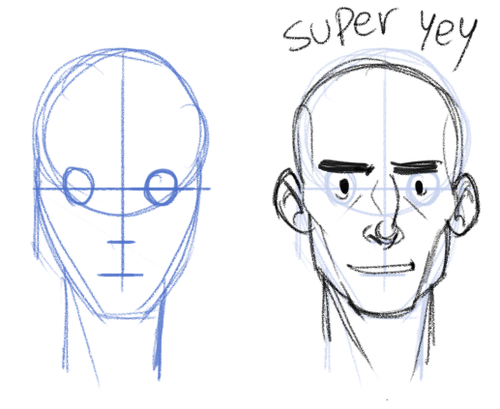ALRIGHT alright alright I’m going to make this some sort of ”beginner artist” masterpost and include as many resources as I possibly can. I am going to assume you want to focus on the ”drawing” aspects of art since it can take many forms. Here are some pointers and resources I consider vital when learning how to draw, things I’ve learned from multiple art oriented courses. This is going to be a very quick and general thing and I’ll make some serious and properly drawn tutorials in the future (the drawings in this one are going to be embarrassing, try to only take the general idea from them) but to start off:
- Before you jump into drawing in any particular style, learn your realism.
This is probably mistake #1 in many young art enthusiasts: they go straight into wanting to draw either anime, or a particular cartoon’s style because a stylized form of art is much more appealing to them than realistic things. Which is valid, but I’ll have you know in order to get any of those styles right, you have to learn the basics AND ONLY THEN proceed to use that knowledge to ”deform” said realism into any style you want. Be it learning from life drawing and observing, pictures online of real people or animals. When you look at a big household name in the artist world’s work, as flashy as their stuff might be, a trained eye is able to tell immediately if the person has proper anatomical knowledge or not, no matter how much they try to mask it with ”this is just my style.” Let me show you an example:
(excuse the 5 minute sketches pls, note these are actually highly inaccurate (the knees should be placed lower on the second drawing and calves shouldn’t be as big as the thighs) but I wanted to demonstrate ”realistic proportions” in contrast to more of a stylized drawing in a really quick way, a google search for ”human anatomy” will bring up much more accurate visual representations of all this so I highly recommend doing that)
But basically in order to play around with anatomy you first need to learn realistic proportions (you don’t need to absolutely master them or anything, but you need to know things like the distance between the forehead, eyes + nose and chin correlate, places where fat stores in comparison to where muscle stores, the size of the forearm until in reaches the wrist/arm are practically the same, arms + hands reach below the hipbone and halfway to the the upper thigh) and only then proceed to bend those rules to create your own stylized version of things, which means you get to play around with a lot of shapes like so:
- USE GUIDELINES
For the love of all that is holy make use of guidelines, whether with a light colored blue or red pencil if you’re drawing by hand or a sketch layer in Photoshop/SAI etc. They will help out so much when it comes to knowing where you should place each feature. Many people attempt to draw directly without them and while after a lot of practice it might work, to start off you really need to understand basic figure building.
(I’m literally drawing all these one drawing a minute excuse the shittiness I’m just trying to get the point across ahah gOD THESE ARE PISSPOOR)
- Carry a little sketchbook with you if you can and draw strangers while riding the train, bus, etc. Just draw whatever you see.
It’s not only entertaining when you might be bored out of your mind but extremely productive to draw people, animals, scenery, anything you can see that you might want to sketch out for practice, you can. No better way to learn than real life.
- Take time to draw. And draw. And draw.
You will not learn or improve overnight, bettering yourself when it comes to art is an endless and ongoing lifelong process. But it won’t be due to osmosis, you gotta sit your ass down and draw as frequently as you can afford to (although excesses can be bad for you, learn to also take breaks and find comfortable positions because drawing CAN REALLY MESS UP YOUR BACK like badly and you don’t wanna end up hunched over because of it or with tendonitis) But believe me: practice makes perfect and if you learn to observe and understand why you’re drawing what you’re drawing, why are you placing that line where you’re placing it and start thinking in 3D, you will surely improve.
Now for the part you truly want to look out for –
RESOURCES
USEFUL BOOKS/AUTHORS
- Andrew Loomis
- Leonardo Da Vinci
- Michaelangelo
- Force: Dynamic Life Drawing For Animators
- If you want to learn how to draw animals
- Basically any artbooks from any games/shows anything that interests you and might inspire you, because inspiration is a big part of this whole matter.
MATERIALS
- Prismacolors for sketching (I recommend blue/red ones)
- A drawing tablet for digital art if you wish to pursue it (a cheap one will do if you are a beginner, no need to go all fancy just yet – I recommend a medium sized one)
- Adobe Photoshop (you can either get a student version of it legitimately, although many people torrent it because of the ridiculous pricetag) OR ALTERNATIVELY PenTool Sai (Free!)
BLOGS WITH AN INFINITY OF TUTORIALS
HELPFUL WEBSITES
- http://www.posemaniacs.com/thirtysecond (for pose practice)
- http://www.quickposes.com/pages/timed (for pose practice)
- http://robynrose.deviantart.com/ (stock photo resources)
- http://senshistock.deviantart.com/ (stock photo resources)
- http://www.springhole.net/writing_roleplaying_randomators/charactergens.htm (for character prompts)
- http://conceptartworld.com/
Last but not least, some artists that inspire me beyond words and that might also inspire you.
- mattrhodesart
- phobso
- shoomlah
- skoptsy
- makanidotdot
- keaneart
- grimchild
- roggles
- theminttu
- leah-smith (one of the people who I grew up with learning from, endlessly thankful)
I hope this helps!



